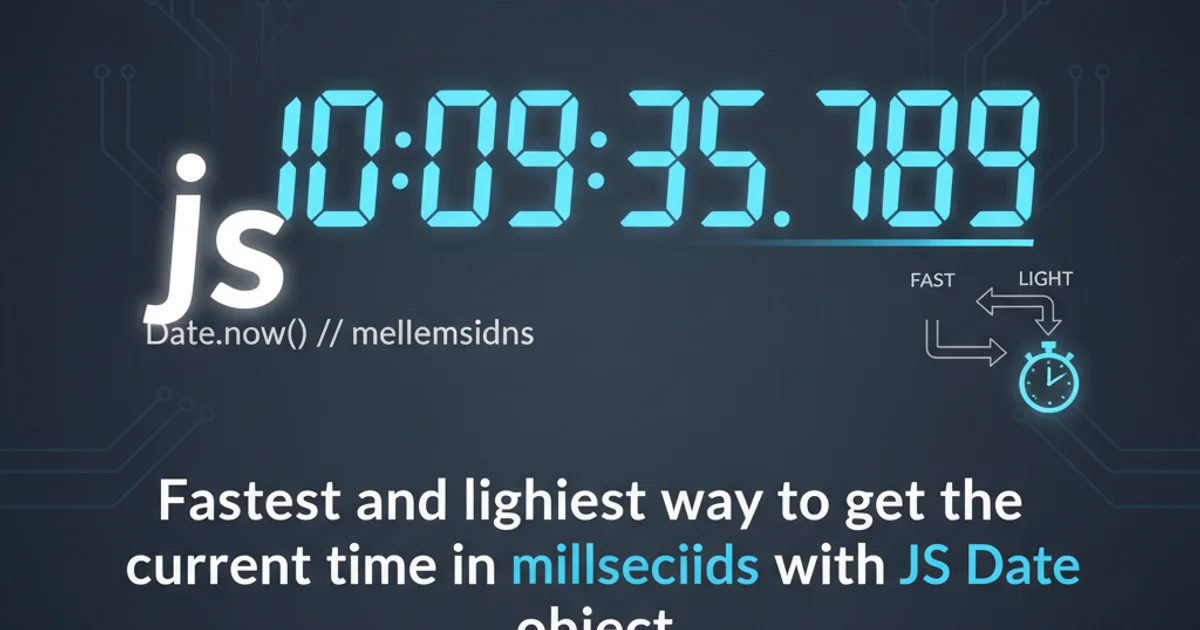Fastest and lightest way to get the current time in milliseconds with JS Date object
Categories:
Mastering JavaScript Timestamps: The Fastest and Lightest Way to Get Milliseconds

Explore the most performant and memory-efficient methods for obtaining the current time in milliseconds using JavaScript's Date object, understanding their nuances and best use cases.
In web development, accurately measuring time is crucial for performance monitoring, animation timing, and logging events. JavaScript provides several ways to get the current timestamp, but not all are created equal in terms of speed and resource consumption. This article delves into the most efficient methods to obtain the current time in milliseconds using the built-in Date object, helping you write optimized and performant code.
Understanding JavaScript Timestamps
A timestamp represents a specific point in time, typically measured as the number of milliseconds that have elapsed since the Unix epoch (January 1, 1970, 00:00:00 UTC). JavaScript's Date object is the primary tool for working with dates and times, offering methods to retrieve these timestamps. While seemingly straightforward, the choice of method can impact your application's performance, especially in high-frequency operations.
flowchart TD
A[Start] --> B{"Need current milliseconds?"}
B -->|Yes| C{Choose Method}
C --> D["Date.now() (Recommended)"]
C --> E["new Date().getTime()"]
C --> F["new Date() + 0"]
D --> G[Fastest & Lightest]
E --> H[Slightly Slower]
F --> I[Type Coercion Overhead]
G --> J[End]
H --> J[End]
I --> J[End]
B -->|No| J[End]Decision flow for obtaining current milliseconds in JavaScript.
The Date.now() Method: The Champion of Performance
Introduced in ECMAScript 5, Date.now() is specifically designed to return the number of milliseconds elapsed since the Unix epoch. It is a static method of the Date object, meaning you call it directly on Date rather than on an instance of Date. This method is widely considered the fastest and most lightweight approach for getting the current timestamp.
const currentTime = Date.now();
console.log(currentTime); // e.g., 1678886400000
Using Date.now() to get the current timestamp.
Date.now() is the preferred method for performance-critical applications. It avoids the overhead of creating a new Date object instance, making it significantly faster than other approaches.Alternative Methods and Their Performance Implications
While Date.now() is the clear winner, it's useful to understand other common methods and why they are less optimal for pure timestamp retrieval.
new Date().getTime()
This method involves first creating a new Date object instance and then calling its getTime() method. While it yields the same result as Date.now(), the instantiation of the Date object introduces a slight performance overhead. For occasional use, this difference is negligible, but in loops or high-frequency operations, it can accumulate.
const dateObject = new Date();
const currentTimeWithGetTime = dateObject.getTime();
console.log(currentTimeWithGetTime); // e.g., 1678886400000
Using new Date().getTime() to get the current timestamp.
new Date() + 0 (Type Coercion)
This approach relies on JavaScript's type coercion. When a Date object is added to a number (like 0), JavaScript attempts to convert the Date object into a primitive value. In this context, it converts the Date object to its numeric representation, which is the timestamp in milliseconds. This method is generally discouraged due to its reliance on implicit type conversion, which can be less readable and potentially less performant than explicit methods.
const currentTimeWithTypeCoercion = new Date() + 0;
console.log(currentTimeWithTypeCoercion); // e.g., 1678886400000
Using type coercion (new Date() + 0) to get the current timestamp.
new Date() + 0 for obtaining timestamps. It's less explicit, can be confusing, and offers no performance benefit over Date.now() or even new Date().getTime().